Between the bustle of Main Street and the zoom of Franklin Street lies the treed and tranquil north end of William Street, Vineyard Haven. It’s one of those select Vineyard corridors that seem to harden the Island’s nineteenth century golden age in stone. On these strips, whaleship captains, shipping magnates, privileged heirs, and their ilk were keen on commissioning in-town homes worthy of their stature. Most of those trophies to new money still stand.
Today’s William Street knows more SUVs than horse-drawn carriages. Flip-flops are the new clip-clops. And once every summer week, just around the corner, people in shorts fidget in line at Grace Church for lobster rolls. Yet William Street still cleaves mightily unto the past. Pedestrians seem to slow down and breathe easier along the streetscape of prim Greek Revivals and Neoclassicals, most from the 1830s to 1860s. Only a couple of late-century Gothic revivals with wraparound porches are the fanciful exceptions. What pulls the William Street look together are the prevailing façades of white clapboards and black or near-black Hunter green shutters.
But then there’s William Barry Owen’s house, the renegade of the renegades. For starters, Owen was an early-twentieth-century corporate mogul rather than an old-timey seaman. (See sidebar, page 41.) And on a street where most houses stand gable to gable, this parcel’s 200 feet of street frontage and expanse of lawn lend the home a mid-century suburban flair. Though the original house is thought to have been built circa 1860, the more defining birthdate is 1920, when it morphed into the hip new Arts and Crafts aesthetic of the times.
It’s shingled rather than clapboarded. It’s gray, not white. The trim boards are a lively yellow, for heaven’s sake, and there is nary a window shutter. A deep side portico, added in the 1990s, suggests the Old South and begs for a round of mint juleps. And in recent years, a pair
of sculpted Asian temple dogs stands sentry at the front entry, teeth bared.
Renegade or not, the curb appeal of the Owen house is beloved even by the William Street Historic District Commission.
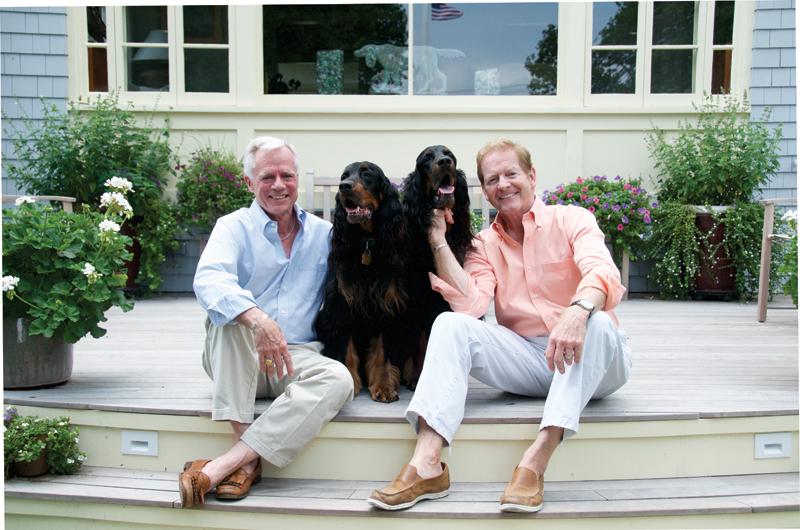
The temple dogs hint at more intrigue inside. Less than five years ago, the décor was a beacon of Tisbury traditionalism and restraint. Today it could pass for a trendy loft in the Meatpacking District of Manhattan. An abstract, made-to-sway metal sculpture stands tall inside the front door next to an African tribal mask. A French art deco cabinet in black lacquer hides the owners’ stash of single malts. A pair of large working swan decoys from New Jersey shares a window habitat with a museum gift shop bird near a display of late-nineteenth-century woodblock prints in delicate hues by Japanese artist Ohara Koson. An unglazed Tang dynasty horse – the oldest thing in the house, circa 720 A.D. – stands between a pair of blue-and-white Ming vases. A bronze sculpture of Rudolf Nureyev arches in full balletic expression before a 1920s cubist painting by Natalie Van Vleck. A boldly colored abstract by Nína Tryggvadóttir hangs over the fireplace.
And that just covers the front parlor – not including the adjacent powder room with the sixteenth-century wooden sculpture of Buddha seated before an Alfred Eisenstaedt portrait of Marilyn Monroe.
Don’t think “clutter.” Somehow it all hangs together.
“There’s a tipping point where we have so much stuff that being eclectic works,” says David Behnke. Plus, it doesn’t hurt to have more than 3,000 square feet of house in which to spread it all out.
Behnke and Paul Doherty purchased the home in 2013. In sharp contrast to their temple dogs, they greet visitors with enthusiasm. They are not in ponytails, wearing black, as one might predict from their bohemian digs. The preppy-looking pair could step right into a Vineyard Vines catalogue. They could crash, say, a fortieth anniversary reunion of the Vineyard Sound collegiate a cappella group.

Their lives are about as eclectic as their home. Doherty, the tall, energized redhead, is an avid photographer and semi-retired actor, often lured to perform in Island theater. Vineyarders have lately come to know his political side; he is an outspoken warrior against “nips,” the tiny liquor bottles that litter many a Vineyard roadside. Behnke of the silvery mane is the reserved partner; this is in relative terms only. When he’s not commuting to see private equity clients in far corners of the globe, the baritone is often singing with a community chorus or soloing in a musical or opera here at home.
Things Doherty and Behnke have in common, to name just a couple, are an appreciation for art and a weakness for collecting. In a previous life, Behnke was a New York–based art consultant, advising corporate clients in their establishment of their own collections. He and Doherty also owned an art gallery near their former weekend home inrural Washington, Connecticut. Until recently, they operated the Behnke-Doherty Gallery, a sleek emporium of modern art and antiquities on Main Street, just a stroll away from home. (Future plans for the gallery are undecided.)
Yet never did they expect to call Vineyard Haven home. As veteran Vineyard vacationers, Doherty and Behnke were up-Island types who cherished the remoteness from down-Island crowds. In 2007 they bought a thirteen-acre parcel in Aquinnah, installed utilities, designed a house. The economic downturn stalled their building plans, and that wasn’t even the worst of it: Doherty was diagnosed with life-threatening hydrocephalus, also known as water on the brain. They conceded that Aquinnah was simply too far from the lifelines of hospitals and ferries.
But not living on Martha’s Vineyard was not an option. “It always felt like home to us,” says Doherty. “We had developed friends. The dogs love it here. And it’s the only place I’ve seen Dave calm down and relax.” “Islands are comforting,” Behnke affirms.
Doherty spent many a late night searching more practical buying options online. “Real estate was my porn,” he says. He got captivated by a video of the Owen property. He could see both the ferry and the hospital from the house. He liked the notion of walking to town to get a newspaper and coffee. “And with my illness, I needed the negative ions that come from being near the water.”

Behnke liked the house at first sight. “The floor plan was perfect. It had a very open feel. And the light! I could see our art in here. The gardens were manageable, and for an in-town home, the property was very private.”
But to make it happen, something would have to give – either the Aquinnah property or Connecticut. And nearly five years after the crash of Lehman Brothers, neither market had emerged yet from the economic doldrums. The Connecticut property had been off the market for a while when their broker called to request a showing to a buyer. Doherty was away in Boston; Behnke was preparing to travel to Brazil. “I wanted to say ‘buzz off,’” says Behnke, who figured the showing would be a waste of time and trouble, but he capitulated. The buyer came, saw, and made a full-price offer. “I asked the broker if he was financially qualified,” says Behnke with a chuckle. Behnke didn’t yet know the buyer worked for legendary hedge fund manager George Soros.
The William Street purchase wrapped up within a week after the sale in Connecticut. “A series of near missteps on our part led us to the right thing,” says Behnke.
“The opportunity evolved at the right time,” adds Doherty. “In a way, it was a gift from God.” An even better gift was Doherty’s amended health prognosis. His illness was no longer deemed terminal. Still, nearly every day Doherty walks along the harbor beach with the two dogs, Gordon setters Chester and Cooper. “It makes me feel grateful to be here.” His migraines have disappeared. So has his vertigo. Doherty’s inspired photos of water reflections, taken from his kayak in the light of daybreak, grace the walls of the couple’s home and gallery, too.
The house may have been “perfect” when they acquired it, but like most new homeowners, they tweaked things a bit. They added a sunny rear deck. Central air-conditioning and an electric generator were installed to ensure consistent climate controls to protect their artwork. Recessed ceiling lights now showcase the art in a better, well, light. A typical mid-century picture window in the living area was ditched for a divided-light motif. Now it replicates the more historically correct window on the upper level. “The Historic District Commission loves that we did that,” says Behnke.
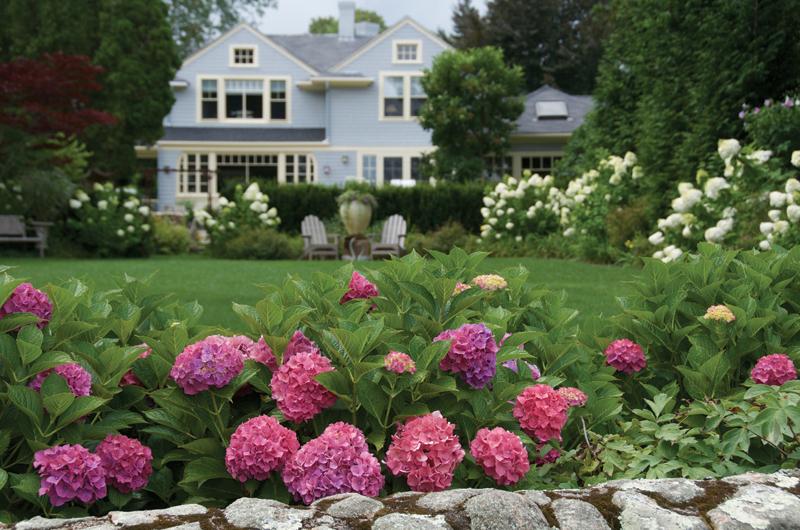
Every wall in the house was white until a leak from an upstairs shower forced a restoration of the foyer. Behnke and Doherty had the space repainted in a pale celery green – Benjamin Moore HC 1529, to be exact. They liked it so much, they wound up repainting the whole interior that color.
From the large remodeled window in the living area – and more awesomely from the window above it – Vineyard Haven harbor is in clear sight. It’s yet another distinction of the property; other homes fronting William Street just get peeks of the water, at best. The backyard of the double-size parcel with its formal landscape, detached guest quarters, and garage rolls down to a stone wall and wrought iron gate on Main Street. The view continues unimpeded across the street and all the way down to the harborfront, by way of Owen Park. Yes, that same Owen. (See that same sidebar.) And Doherty is right: one can see clear across the harbor to the hospital.
“When we’re expecting guests arriving on the ferry, we know it’s time to go pick them up when we see the boat come across the view,” he says.
Still, the interior scenery vies for as much attention. A jazzy tiger-maple highboy, circa 1740, lords over the living room. Behnke says it’s a transitional piece – “a William and Mary top, married to a Queen Anne bottom.” Wooden decoys and shorebirds flock about the house, including a duck by the late Herbert Hancock, one of the Vineyard’s iconic carvers. Collecting decoys and birds is Behnke’s thing and a Vineyard inspiration. Collecting small Japanese bronze rabbits, mostly in pairs, is Doherty’s thing. “He went through a phase,” explains Behnke.
There is no overlooking an entire wall of jumbo stoneware jugs – twenty of them at this writing. Another of Doherty’s things. He’s drawn to historic stoneware of the northeast U.S. in particular. A disconcerting “slave jug,” circa 1780, features a painted image of a black woman bent over, with horseshoe marks on her buttocks. The Peabody Essex Museum borrowed the piece, as did the St. Louis Art Museum for a five-city tour. According to Doherty, when Leslie Keno of Antiques Roadshow renown saw the jug on exhibit in Connecticut, he declared: “That’s the piece that’s always haunted us.”
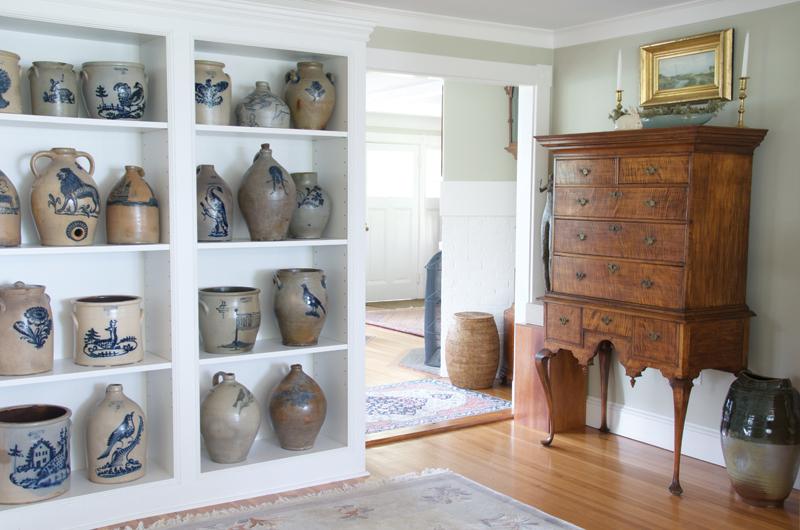
Contemporary stoneware also get their due on Doherty’s wall. Three jugs by a local artisan were sourced at the former Shaw Cramer Gallery in Vineyard Haven. Doherty means no disrespect when he says: “We used to keep dog food in them.”
“Our tastes have evolved in our last thirty-four years together,” says Behnke. “Fortunately, we’ve moved in tandem. We each have specific things we focus on, and we rarely disagree on art. On the very rare occasions when one of us hates something, we won’t buy it.”
The day they closed on the purchase of the Owen house is the very day Trip Barnes’s moving trucks pulled up to the doorstep with their belongings from Connecticut. It’s astonishing to learn that Doherty and Behnke actually downsized possessions before the move. “Our Connecticut house was twice as large as this one and packed with art and stuff,” says Doherty. “High-end stuff, but it was…stuff.” They managed to empty the house in a week’s time, turning a local church sale into one heck of a success that year. In the process, they let go of about half of their art. Surely a heartbreaking farewell?
“No,” says Behnke.
“Yes,” says Doherty.
Behnke: “The move forced us to decide what we were really emotionally attached to. It was cathartic.”
Doherty: “I went dumpster diving through the stuff Dave threw out.”
The décor of the Connecticut house was purely eighteenth-century Americana when they bought it, according to Behnke. It’s why Doherty called it the “brown house.” “By the time we left, the décor was Chinese, Japanese, and art deco,” says Behnke. “We had come to realize that a house does not have to be a museum. It can reflect what we like.”
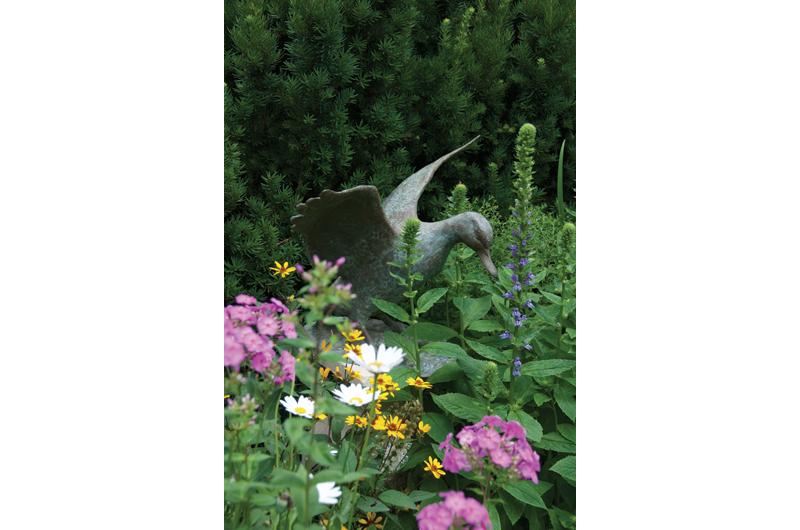
And so it goes on William Street, where African tribal masks and sculptures share the limelight with Doherty’s pedestrian and very Vineyard collection of beach glass. Behnke’s love affair with African art emanated from his global business travels in the 1990s, which
in turn inspired the launch of his art consulting sideline. Travel similarly piqued Behnke’s interest in fine Asian collectibles – “like the celadon and other pieces I don’t understand,” says Doherty. The only shipping casualties to date have been a pair of large unglazed horses from China. Doherty opened the boxes upon their arrival in America only to find dust.
The décor hardly loses its nerve on the home’s upper story. Abercrombie and Fitch, two huge stuffed bears Behnke acquired from a certain iconic emporium, inhabit two of the bedrooms. A bunch of little stuffed bears perch on a cabinet. Furnishings run the gamut from a Chippendale chest of drawers to a pair of art deco chairs from a Beijing club, chairs by iconic woodworker George Nakashima, and an antique tiger maple trunk that holds the urns of the ashes of the couple’s dear, departed dogs. A custom case displays Doherty’s extensive vintage watch collection, including a piece by the late Tom DeMont of the Edgartown Scrimshaw Gallery. A shelf is devoted to a select few of the hundreds of antique bottles Doherty unearthed while gardening in Connecticut. In a front bedroom, a Japanese scroll hangs nearly to the floor of one bedroom, shielded by a layer of plexiglass from the inadvertent slobber of the resident canines. A bathroom features a sultry framed photo of Paul Newman.
The only unifying elements in the home – apart from Benjamin Moore HC 1529 – are the custom-hewn lookalike beds in each bedroom. One might also mention the ubiquitous Asian carpets, though each is a unique work of art in its own right.
In the cozy guest house with the country feel, the main attention grabbers are an imposing pair of French art deco cheetahs, gleaming in chrome on the fireplace hearth.
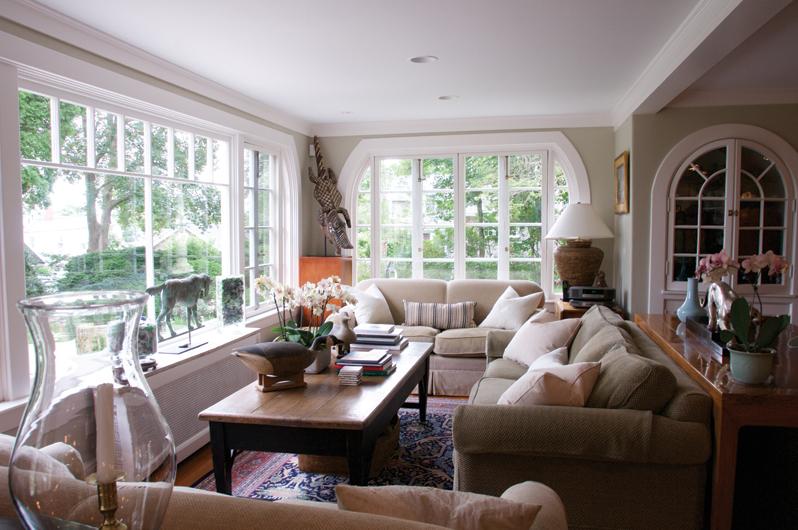
On walls throughout both the main house and guest quarters, the large and avant-garde hang boldly alongside tranquil, representational landscapes and waterscapes. Urban grit meets rural New England, and even the narrow back staircase is a gallery. Until moving to William Street, it never dawned on Doherty that their beach scene by Vineyard watercolorist John Holladay depicts the nearby stretch of harborfront that has become his virtual therapy clinic.
Behnke seems to treasure artists and their back stories as much as he treasures their art. Herman Maril was a painter and bon vivant on the Provincetown scene. Charles Cajori painted with Willem de Kooning. “De Kooning took off; Cajori didn’t.” Natalie Van Vleck, one of a select few women cubist painters of the 1920s, “lived like Katharine Hepburn, dressed like a man,” and eventually quit art to buy and run a sheep farm. An oil painting in brilliant yellow is the work of a Chinese artist forced to leave China.
Could those water lilies over the bed be a (gulp) Monet? “No – and it’s the closest to having a Monet we’ll ever get,” says Behnke with a grin.
Even as the gentlemen take comfort in the privacy of their personalized nest, they embrace the neighborliness that surrounds them as well. “Paul could tell you the name of every person on William Street,” says Behnke, the frequent flyer who spends less time at home than his partner. They gather socially with nearby neighbors, mainly in the quiet of winter. If they do a day trip to Boston for a medical appointment, a pot of stew might greet them on their front step when they return home.
Doherty shovels snow for some neighbors. In return, an anonymous donor once left an ergonomic shovel with a bow on it at their door. Surely those sculpted temple dogs guarding the realm didn’t so much as growl.
The Backstory: Of Talking Machines and Chicken Farms
Your name may be on the deed, but your historic Vineyard home may forever be known as, say, the Smith house or the Captain Waters house or old Mrs. Jenkins’s house. And so it goes with the William Barry Owen property, currently under the stewardship of David Behnke and Paul Doherty. Owen never occupied or even saw the house, mind you. It’s his grand vision for the property that keeps his name virtually engraved on the hearth.
As a young man he had the good fortune to attend college and law school, thanks to the success of his father, a Vineyard-based Arctic whaler. And he eventually made a fortune of his own as one of the founders of the Victor Talking Machine Company, a predecessor of RCA. After living and working in London for some years, he returned to Vineyard Haven in 1903 with grand intentions to develop a swath of land and buildings stretching all the way from Franklin Street, across William and Main Streets, and down to the harborfront. The highlights of his scheme were a formal English garden and a mansion to replace a preexisting building. It would have a clear view all the way to the water – but for three houses between Main Street and the harbor that stood in the way. It was a temporary issue; he had the houses moved farther up the road.
“I thank Owen every day,” says Behnke, as he gazes out his rear window.
But Owen’s dream of the mansion was never fulfilled. He fell into disagreement about the property with the Tisbury assessors, according to lore, and found a new life’s direction on a chicken farm in North Tisbury. He died in 1914. Five years later, in his memory, Owen’s widow gave the town the land he had cleared between Main Street and the water. Owen Park was born. In the 1920s, new owners expanded and remodeled the building into the Arts and Crafts home that subsequent owners – lately Behnke and Doherty – have reimagined with visions of their own.

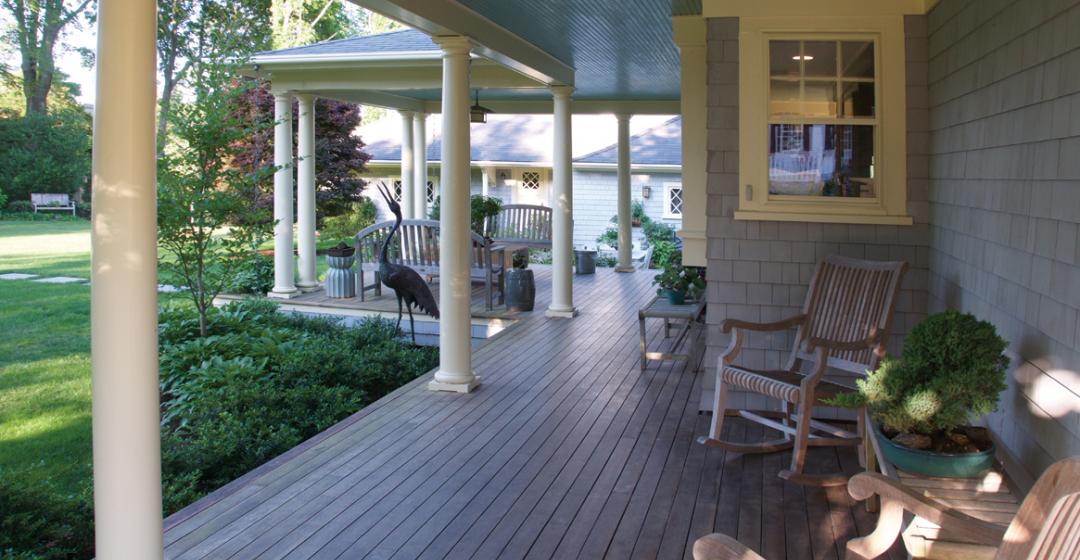


 1 comment
1 comment
Comments (1)